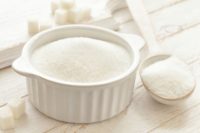Ingredient Technology: Sweeteners, they come naturally
Thanks to growing concerns about sugar, alternative sweeteners are on the rise and natural substitutes are becoming more and more accessible.










With consumers growing increasingly worried about the potential detriments of eating too much sugar, the hunt is on for the best alternatives.
According to the NPD Group, sugar is now the top item consumers try to avoid in their diets. It edged out fat, the reigning champ since 2004, for the top spot in 2014 for the first time — 65 percent of adults want to cut down on sugar, compared to a close 63 percent for fat.
Consumer attitudes can be seen reflected in the increase of case shipments of sugar substitutes from major food distributors to restaurants and other foodservice outlets. Case shipments of bulk sugar substitutes to foodservice outlets increased by 22 percent in the year ending August 2015, according to NPD’s monthly tracking service SupplyTrack. Shipments of stevia increased by 11 percent, charting a greater increase than any other sugar substitute.
But just reducing sugar isn’t the only concern. As the sweeteners segment continues to grow, so does the sophistication when it comes to finding suitable replacements for sugar.
“Although we know sugars and calorie reduction are important to some consumers, that doesn’t change the fact that taste is king,” says Sanjiv Avashia; principal scientist; Bakery, Snacks and Confectionery; Tate & Lyle. “The 2015 IFIC Food and Health Survey tells us that taste continues to be the top factor impacting consumers’ purchases. Therefore, manufacturers need a sweetening tool kit that meets consumer demand for the best of both worlds — reduced sugars and calories and great taste.”
Enter Tate & Lyle’s Dolcia Prima allulose. Introduced early 2014, it’s a low-calorie sugar that retains the taste and functional attributes of table sugar, but with 90 percent fewer calories. These attributes mean it can be used to partially replace table sugar in applications like gummies, fruit chews, and chewy caramels. It can even be used in confectionery fillings and toppings.
And while Dolcia Prima allulose can work on its own to reduce calories, it can also be paired with high-potency sweeteners like stevia to reduce sugar. Dolcia Prima allulose is synergistic, says Avashia, when integrated with Tate & Lyle’s zero-calorie Tasteva stevia sweetener.
“We’ve used Dolcia Prima allulose and Tasteva stevia sweetener in gummy candies as partial replacement of sucrose and corn syrup,” says Avashia. “Dolcia Prima can partially replace sucrose and a traditional 43 DE corn syrup in gummy candy in order to achieve a reduction in calories while maintaining chewy and elastic texture with excellent clarity.”
All this without any significant changes in the processing and handling of those gummy candies.
In Japan, the Matsutani Chemical Industry Co. is also working to bring allulose to the market. Astraea allulose is the result of decades of research by Kagawa University professor Ken Izumori.
The search for micro-organisms that function in a unique way began in the 1970s, says Yuma Tani, R&D deputy manager, Matsutani. In 1994, he found an enzyme that converted from fructose to allulose. The process involves an enzyme called “D-allulose-3-epimerase” making the conversion from one monosaccharide to another.
Speaking of monosaccharides, that’s what table sugar is made of. It’s a combination of two most people are familiar with: glucose and fructose.
“Glucose is the only energy source that the human brain can utilize, and we need it in our lives. The real issue, however, is that we occasionally overconsume the monosaccharide,” says Tani. “Because of its zero-calorie content, allulose will help to maintain calorie intake and blood glucose control.”
Astraeaallulose is characterized as a “rare sugar” — one of about 50 that occur in nature. It carries 0.2 K/cal per g. and provides a sugary flavor with no aftertaste. According to the FDA Specific Requirements for Nutrient Content Claims, Astraea can be labeled a zero-calorie sweetener, making it the first natural sweetener of its kind.
“Unlike high intensity sweeteners, Astraea allulose has bulking, browning and sweetening properties just like sugar, but it is a zero-calorie alternative,” says Tani. “As a result, it maintains the healthy consumption of food intake.”
But, of course, there are tried-and-true sugar alternatives.
Honey is a natural, incredibly diverse ingredient that has positioned itself as a go-to sweetener among artisan confectioners and large-scale candy producers, says Catherine Barry, director of marketing, National Honey Board.
In the United States alone, there are more than 300 varieties of honey, with unique flavor profiles that work with both delicate candies and richer treats.
“Many confectioners are finding value in honey’s indulgence and depth of flavor, capitalizing on the taste and mouthfeel that honey contributes to a range of candies,” says Barry. “For more delicate candies, a confectioner may use clover or orange blossom honey. For a more rich, indulgent treat, they may use a darker honey such as buckwheat.”
Not only is does honey provide diverse options for confectioners, it’s also highly marketable. Popular honey iconography, such as honeycomb, bees and the honey dipper, are used as key marketing tools across the food and beverage industry, says Barry.
And the ingredient is certainly worthy of its good reputation. It’s a natural source of energy as well, with 17 grams of carbohydrates per tablespoon, making it a perfect ingredient for bars and candies that target endurance athletes and the energy market.
So it seems the alternatives are there, especially at a time when manufacturers are looking to both maintain delicious flavors and expand on their sugar free offerings.
But whether confectioners choose timeless classics like honey or newer innovations like allulose, it seems like natural is the way to go.
Looking for a reprint of this article?
From high-res PDFs to custom plaques, order your copy today!












